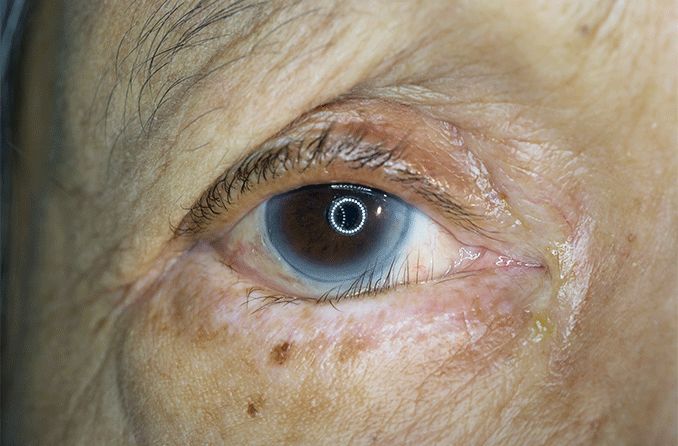Entropion: Causes, symptoms and treatment

Entropion is a condition that causes the lower eyelid to fold inward so that the eyelashes and skin touch the surface of the eye. It is commonly caused by weakened muscles in the eyelid due to aging and can cause eye redness, pain and excessive tearing. Entropion can be treated by taping the eyelid, applying eye lubricants and having surgery.
What is entropion?
Entropion, whether due to age, scarring, congenital defect or inflammation, causes the lower eyelid and eyelashes to turn inward and rub against the eye, causing discomfort and irritation. The eyelid may turn inward constantly or only when the eyelids are squeezed shut.
According to the American Academy of Ophthalmology, involutional entropion is the most common type of this condition and occurs most frequently among the elderly. Involutional entropion is the result of a breakdown in collagen, which naturally occurs with age, and can sometimes be attributed to cataract surgery.
The entropion eye condition can injure the cornea and eventually lead to vision loss. Entropion usually affects only one lower eyelid, but it can occur in both lower eyelids.
Other types of entropion include:
Cicatricial entropion can be the result of scarring or inflammation caused by eye infections or previous eyelid surgeries. This scarring causes the tissue in the eyelid to be shortened or contracted.
Congenital entropion is rare and appears at birth or shortly thereafter. It occurs when the eyelids are not positioned correctly.
Spastic entropion is caused by inflammation and dryness. This irritation often results in eye-rubbing or squeezing the eyelids shut for relief, which can cause involuntary muscle spasms that make the eyelid roll inward against the eye.
Symptoms of entropion
Symptoms of entropion include:
Excessive watering and tearing
Mucous discharge and crusting
Light and wind sensitivity
Entropion repair and treatment
A short-term solution for entropion is the use of skin tape, an adhesive made specifically for the skin. At night, apply a small piece of tape vertically to the cheek to pull the lower eyelid down enough so that it does not turn inward while asleep. It is important to ask your eye doctor for clear instructions before attempting this home treatment.
Other temporary remedies that may relieve discomfort include:
OnabotulinumtoxinA (Botox) injections — The toxin temporarily paralyzes the targeted muscle and provides relief in some cases of entropion. This safe outpatient procedure offers at least temporary but immediate improvement.
Bandage contact lenses — A soft contact lens, available with or without a vision-corrective prescription, may be recommended by your eye doctor to help protect the eye from being injured by the eyelashes.
Artificial tears and eye ointments — Eye drops are recommended for daily use to help lubricate the cornea while ointments are suggested for use at night. A plastic moisture shield is also recommended to wear over the affected eye at night to keep the ointment in place.
Entropion surgery
If these remedies don’t improve the symptoms, your eye doctor may recommend surgery. If the surgery is related to the muscles and tendons sagging due to age, the surgeon will remove a small part of the lower eyelid, leaving stitches below the eyelid or in the corner of the eye.
If there is scar tissue inside the eyelid, whether from a previous surgery or injury, the eye doctor may perform a skin graft.
Prior to surgery, a local anesthetic will numb the eyelid and surrounding area, and you will be sedated. Once the surgery is completed, your eye doctor may prescribe an antibiotic and steroid ointment to apply to the eye for one week. An eye patch may also be recommended for the next 24 hours in order to properly protect the eye. Stitches are usually removed within a week of the surgery.
Cold compresses are helpful in relieving the normal, temporary swelling and bruising that will occur and should only remain for about two weeks after surgery. As the eyelid heals, any tightness or discomfort should subside.
Entropion vs. ectropion
Ectropion and entropion eye conditions similarly affect the eyelid. While ectropion causes the eyelid to turn outward, entropion forces the eyelid to turn inward. Both entropion and ectropion usually affect only the lower lid and could affect one or both.
While the conditions have opposite effects on the eyelid, the symptoms of ectropion are similar to entropion and include:
Gritty and dry eyes
Eye irritation
Bacterial infections, such as conjunctivitis, become common
Excessive tearing
Blurry vision
Eye pain
Light sensitivity
Both eye conditions can be caused by weakened eye muscles due to age, eye infections, a congenital disorder, inflammation and scar tissue. Treatment options are similar for both entropion and ectropion.
READ MORE: More eye conditions and diseases
When to see an eye doctor
If you notice any changes in your vision or think you might be experiencing entropion symptoms, call your eye doctor immediately. Regardless of your vision needs or presumed eye health, it is recommended that you keep up with routine eye exams to maintain a healthy vision system and manage your overall health.
Page published on Wednesday, January 27, 2021






